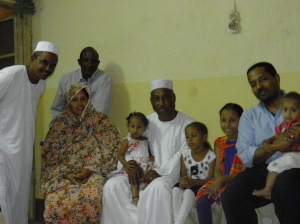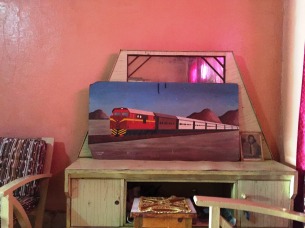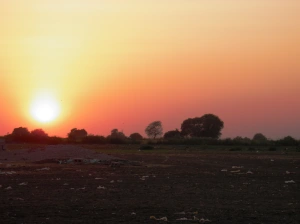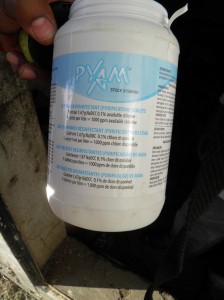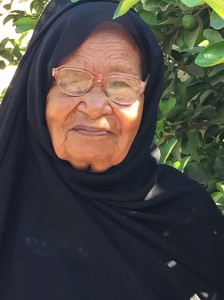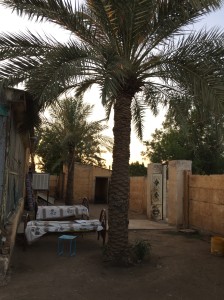We woke up knowing that we had a long journey ahead of us back to Khartoum. Word had gotten around from our evening visit that we were interested in knowing more about New Halfa and old Nubia from the elders.
Ustaz Rushdie came to see us again, and was far more emotional than the evening before, explaining that we had provoked in him a longing for home. Madame Amina came back wearing the traditional Nubian dress, the jirjar, so that we could photograph her as we had asked. In a few hours we manage to see five or six more families.
We went to see the farms and the water supply that we described in an earlier post. With a lot of blessings and well wishes from the elders, the best kind of blessing, we were off.

On the route back to Khartoum we stop in Gedaref, the agricultural center of Eastern Sudan. It is a busy day at the market, despite it being a Saturday, since the sesame crop has been harvested, and many sacks of it are being exchanged. It was a few days before Mawlid al Nabi, the birthday of the Prophet, and the markets were full of colorful decorations and sweets. We stop momentarily to meet the lovely family of the driver in Gedaref. It is a brief visit, and it is clear that the children miss their dad. A few tears were shed.
We spend a little time in the town, seeing people meeting and greeting, and getting ready for the holiday.

Seeing this town reminded me of a trip I had taken as a 20 year old. Back in 1987, as university student, I had won a small scholarship to travel to Sudan in order to research my senior thesis comparing traditional and modern agriculture. I had spent a few days in Gedaref with Wagdi in 1987 to better understand the more modern parfo The question was whether the semi-mechanized model in the rain-fed agriculture sector around Gedaref would flourish as an alternative to the traditional agriculture that was practiced among the Sudanese who lived in scattered villages.
Later that summer I wanted to see what traditional agriculture was like. I decided to go to see a small town called Umm Ruwaba, which is half way between Khartoum and Darfur. My relatives did not want me to go alone, so they sent an older cousin who is now a school teacher. But there was only one seat left on the bus. I had nowhere to sit since a merchant was transporting six large jerrycans (five gallon plastic jugs) of cooking oil on the bus that he wanted to sell in the village. Feeling a little guilty for taking all of the space, he offered me to sit on one of his large plastic containers. I sat down and grabbed a pole as we made our way to El Obeid. As the road bumped along, I held on to the roof of the bus and bounced on the large jerrycan.
The city gave way to the greenbelt, which in turn gave way to the dusty desert as the long path of asphalt stretched forward to the West. Abruptly, after two hours, the asphalt simply ended. Undounted, the driver slowed down, eased the minibus off of the asphalt, and pressed on into the desert. At this point the road became a roller coaster, lifting me off of the plastic, into the air, and back down on to the plastic jug. I became dizzy, my head throbbing, nausea growing as the minibus drove over sand dunes. After another hour I looked down and saw a patch of darkness on the edge of my thigh. I turned to look at the source and saw that my pants were fully soaked in oil, as well as the back of my shirt and my body.
After hours of this we finally stopped. I stumbled out into the dusty street in a daze, about to collapse. I became ill in the street. I found a faucet and washed my face. I had a piece of paper with an address on it, and I asked someone to guide me there. It was easy to find, since everyone knew everyone else. I knocked, a little kid opened the gate and let me in. The mother of the family, seeing what a mess I was in, led me to a guest room; they showed me a bathroom and shower and I promptly changed and fell asleep until late the next morning. I woke up, and my clothes soaked in cooking oil had been laundered and were folded next to me. They gave me a wonderful breakfast, only a little of which I could eat. He suggested we see a doctor. We went, and under a dim lightbulb the doctor drew a drop of blood, spread it on a glass slide and examined it under a microscope. He gave me the news. I had Malaria. We got some medicine and went back home at he insisted that I go back to bed, which I did because Malaria makes one very sleepy. At that point, before I dozed off, he had a question he was longing to ask. “Who are you?” he asked. His family had taken me in, saved me from a deeper illness, fed me and washed my clothes, without ever asking my name. When I told him, he was quite happy. I stayed for days until I was strong enough to do a little of my research. But it was a sign of the strength of the social fabric, and the depth of relations between people, that one could literally trust your life with it, and that he would have done so much for me without ever asking my name.
In the 28 years since that summer, the Sudan has changed dramatically. The population was around 18 million then, and now it has more than doubled to around 37 million. At that time the Sudanese Prime Minister had been democratically elected, but the government was struggling with the economy. A coup ended the regime and the brief second try at democracy. Wars became the norm. In 1983 Southern rebels led by John Garang resumed a war that had been in hiatus since a 1972 peace agreement, and other conflicts emerged in the East and West. Agriculture was the central focus, and the country had just come out of the devastating droughts in 1984 that were the subject of various concerts around the world.
During the 1990s the new regime, at the time a combination of Islamist and military, largely isolated from international lenders, had deeply cut subsidies and public sector wages to bring budgets under control. To its credit, it stabilized the economy, but this broke the back of the middle class as consumers of staples that had become dramatically more expensive, and as teachers, doctors and civil servants who could no longer make ends meet.
Late in the decade Sudan started to export petroleum and, for the first time in recent memory, the currency strengthened rather than fell. As a result, business started to focus on imports and consumption, Khartoum grew both because of the spending in the capital, and because Sudanese living in the conflict zones fled there for safety. Khartoum for a short while became one of the biggest markets in the world for passenger vehicles. But an oil sector might support increased consumption, but it does not create many middle-class jobs. It tends to concentrate a lot of wealth in a few pockets and in the government. It can help the country develop, and indeed the countries roads were far better. But far too often it can fuel conflict by shifting more resources to security, create opportunities for corruption, make governments unresponsive to society, and create more inequality.
In Sudan, it seemed that the newfound wealth created a new elite, but one that didn’t seem to be fully accepted by society, and a new set of values that don’t seem to fit the people. It seemed that the social fabric of the country had been torn up and sewn in a patchwork pattern; you could recognize the individual pieces of the old Sudan here and there but the overall texture, look and feel of the cloth had changed. Many of the pieces are frayed and tattered.
So it was of great pleasure to see as we passed through the market in Gedaref, and a sesame milling plant that was at capacity; agriculture was back. It is again creating jobs and livelihoods for ordinary Sudanese, as well as migrants from Ethiopia and Eritrea. People were working.
As we drove the five hours back to Khartoum, I wondered if the succession of South Sudan would have a silver lining. I had always seen it as both a victory for self determination and a failure of imagination – a failure for ordinary people to see each other’s humanity, and a failure of leadership to help them see it. Without oil income, and with a return to agriculture, would the older egalitarian values that come from hard work return? Would that torn social fabric begin to heal itself?




